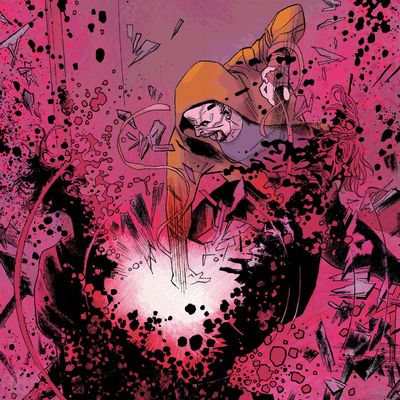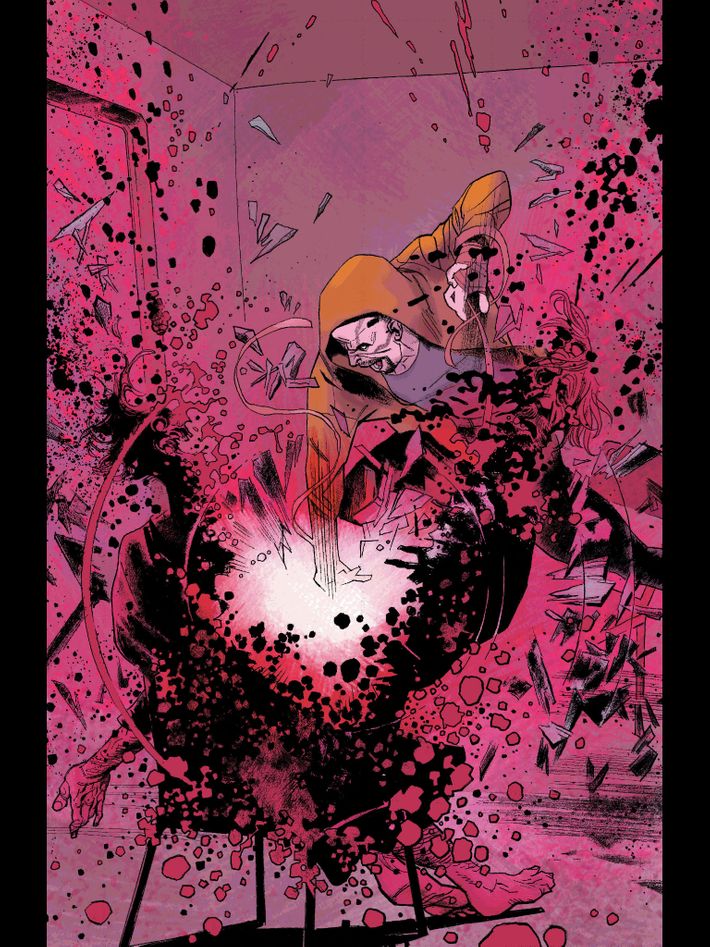
Last fall, while at the Comikaze comic-con in Los Angeles, I attended a press gathering with the best-known name in comics history, nonagenarian Marvel impresario Stan Lee. At one point, he recounted the frustrations he felt with his boss in the years before his industry-revolutionizing run as co-creator of icons like the Avengers, the X-Men, and the Fantastic Four. “All that he said to me was, ‘Forget about dialogue, forget about characterization. Gimme action!’” Lee said. “‘I want a lotta fight scenes on every page!’”
Lee hated that approach and instead built the Marvel empire on a foundation of empathic character-building and slick banter — but with all due respect to Stan the Man, sometimes a great bit of action really can win the day.
The fifth issue of Marvel’s Karnak has plenty of writer Warren Ellis’s trademark high-minded chatter sessions, many of them made more dynamic thanks to excellent facial “acting” on the part of penciler Roland Boschi. But the book’s standout moment is dialogue-free and extremely violent. It’s a full-page panel on page 17 that stuns the reader, one that centers around a fatal blow delivered by the title character. You can consume it in an instant, but a pause to break it down reveals a tremendous amount of craft.
First, though, some necessary background: Karnak is a longtime Marvel character, dreamt up by Lee and writer-artist Jack Kirby in a Fantastic Four story from 1965. He’s one of the Inhumans, a secretive group that traditionally bathes its members in a substance called the Terrigen Mists, which endows them with metahuman abilities. Karnak was never exposed to Terrigen, yet still manages to be one of the most powerful of his people. A genius-level intellect, he trained himself to be able to find the fundamental flaw in any object. Traditionally, this has meant shattering stones, weapons, and (occasionally) humans by striking their weakest points. It’s a clever conceit that often lends itself to breathtaking visuals. This page is one of the best recent examples.
It comes at the conclusion of a round of interrogation Karnak conducts with a mysterious religious acolyte known as Russoff the Painter. He’s spent a few pages deftly taunting Karnak, winding our protagonist up to a breaking point. “Flaw? You want to see a flaw?” Karnak shouts on page 16 before rising to a battle stance. Flip the page and you get the image below, in which Karnak brings a few fingers down on Russoff’s head, causing him to explode into a spray of little globs.

Pulitzer Prize–winning cartoonist Art Spiegelman has often spoken about comics’ ability to cut past your defenses and stir your soul with simplistic brutality. Here is a page that offers living proof of that argument. Without thinking, you’re immediately thrilled and repulsed by the gruesome image of Russoff splitting in half, a pink glow bursting from what was once his chest. Karnak later says the man was “a human land mine” — apparently, he contained an explosive — a nice gift from Ellis to Boschi for maximum bodily disfigurement.
The subsequent gift to the reader, then, is the destruction of a human body in a way that, to be honest, defies your expectations of what’s allowed in a mainstream comic. The two halves of Russoff’s head are suddenly 180 degrees away from each other — his limp, frowning face spins toward us on the right; the rest of his skull faces the other direction. There are little pieces of flesh cascading up, out, and down, but we have a slumping hand and a pair of leaning feet to remind us that those pieces once comprised a man.
Colorist Dan Brown is a superstar here, as well. He doesn’t individually color every bit of viscera with blood. He goes for something more subtle, yet somehow still devastating: He implies and expands the blood by shading the entire page in varying degrees of red and pink. That decision is made all the more impactful by the fact that the previous 16 pages have largely relied on chilly greens, greys, and blues. The contrast jolts you out of your seat.
There’s even a bit of possible homage to Karnak’s origins. Kirby forever changed sci-fi artwork by introducing so-called “Kirby Dots” to the visual lexicon: little circles, surrounded by light, that convey a massive discharge of energy. Here, we see that little bomb exploding and specks of black emanating from it, but in a terrifying little twist, they’re not Kirby’s abstractions — they’re very real pieces of an ex-person.
I would love to see Ellis’s script for this page. He’s self-admittedly very controlling in his directions to artists, so it’s entirely possible that this composition was described in detail and executed with horrifying precision by Boschi and Brown. Alternatively, he may have only given a loose sense of what he wanted, in which case he was apparently wise to trust in his artists’ judgment. Either way, this is a viciously memorable bit of comic-book violence, one that takes the core idea of the series’ lead and takes it to a logical — and delightfully disgusting — extreme.




